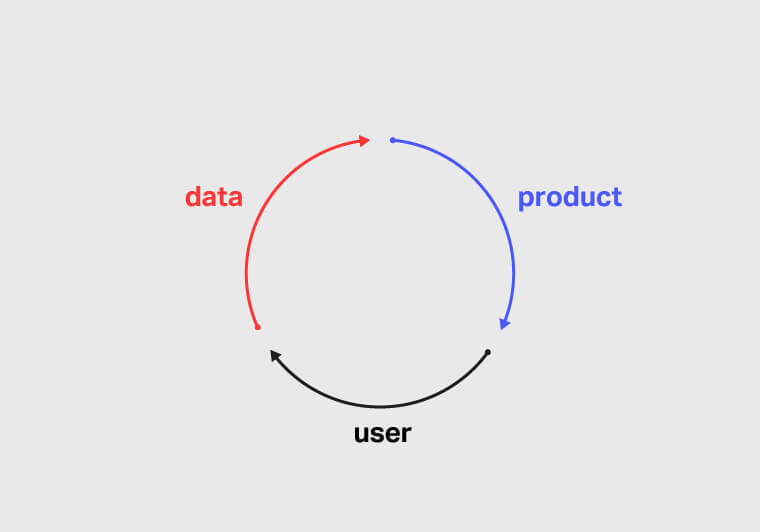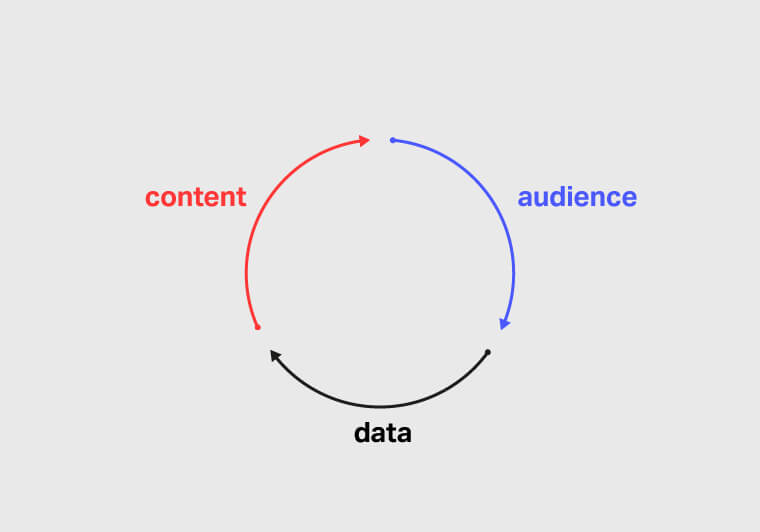Andrew Ng, Baidu’s former Chief Scientist (who also led Google’s deep learning project), recently brought up an interesting strategy he recommends to AI startups.
The idea is simple – data is a more defensible asset for AI businesses than algorithms are. So if you invest in a dataset that no one else has, you can quickly turn that into a positive feedback loop.
Get the data > Make a product > Get users > Get more data > Make a better product > Get more users and so on.

It’s a kind of network effect – and therefore an extremely potent strategy if you get it right, as demonstrated by Google’s almost unassailable lead in search.
Anyone can build a search bar. But no one has the data Google does.
Their data is their moat.
What we talk about when we talk about content marketing
It’s been a long time since I heard anyone talk about the point of content marketing. And I don’t mean the ‘to engage people’ bullshit.
I mean what unique advantage can consistently great content accrue a brand?
To my mind, the moat we can help businesses build with content is an audience that keeps coming back.
(And to be clear, I don’t subscribe to the notion that everyone you throw an ad at is an ‘audience’. They’re only your audience if they came for you.)
The feedback loop we’re trying to optimize for goes something like:
Make great stuff they need > Get their attention > Learn from them > Make more great stuff they need > Keep their attention > and so on.

Like any good strategy it’s simple on paper but intensely challenging to execute.
You have to stay focused on a coherent vision, commit to serving an audience (not just selling to them) at significant cost and make great stuff over and over and over and over again.
It’s so hard in fact that it makes perfect sense for a lot of businesses to not even try doing it.
But then you look at the businesses that did commit to doing just this and you see the compounding value of consistently serving an audience with content they care about.
I mean Andreessen Horowitz. I mean First Round Capital. I mean Stripe. I mean Apptio’s TBM council. I mean Unthinkable.
These are businesses that have slavishly served the people they want to work with.
But isn’t everyone drowning in content?
It’s true that the people we’re trying to reach with content are practically drowning in the stuff. It’s true that content marketing has become table stakes. It’s also true that competing on content alone hardly seems like it’s enough anymore.
Raise your hand if you’re having uncomfortable conversations about the need to invest in paid media to promote content.
Wasn’t the whole point of content to get away from big-budget advertising? Wasn’t the content supposed to be so god damn good it’d promote itself?
Well, yes.
But while it’s true the bar is incredibly high for content to be able to pierce through the noise, that’s only a problem if you’re going to do what everyone else is doing.
If you try to do what no one else in your space is doing, it’s an opportunity.
The first step on the road to building an audience is giving them something they aren’t getting anywhere else.
For a16z it was management advice that helped founders become operators.
For Stripe it’s practical advice that helps people start an internet business.
For First Round it’s the best tactical advice on the Internet.
For Apptio it’s the framework propping up a whole new discipline in IT finance.
For Unthinkable it’s the vision and manic enthusiasm of Jay Acunzo.
This is all content that a) was incredibly hard to make and b) came from people who were uniquely placed to create it.
They knew something their prospects didn’t know.
For the AI startups that Ng is advising, the data is more defensible than the algorithms only when it’s data that no one else can get.
For brands that are thinking about content I think this is the bar to be aiming for.
What do you know about what your prospects are trying to do that they don’t?
Who do you know that your prospects don’t?
What do you have access to that your prospects don’t?
Don’t just build a content brand. Build a moat.
There are no doubt many other kinds of unique advantages that could be turned into valuable content.
But whatever they are, the important thing is to make sure your content brand isn’t just a bunch of stuff everyone else is saying with your logo on it.
Your content brand can be a proprietary, defensible asset – or it can be crap.
The harder it is to get to the insights, relationships, data and people that make your content worth reading/viewing/listening – the more your prospects will want it.
The more your prospects come back for the stuff you’re making, the more defensible your brand becomes.

Enjoyed this article?
Take part in the discussion








Comments
There are no comments yet for this post. Why not be the first?